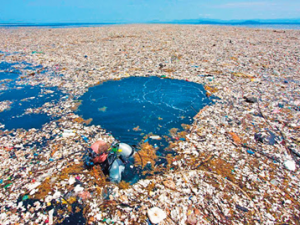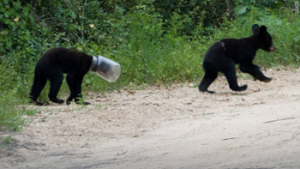It’s Holiday Time Again. We Can Do It Better.
The observance of December religious holidays can be a source of spiritual, family, and community enrichment or, as it is for many, a descent into anxiety and consumerist hell. But we have other choices.
All life on earth is based on consumption, but the human species has raised it to a neurotic and environment-threatening obsession.
The eddies of packaging waste in the Pacific Ocean between California and Hawaii dubbed The Great Pacific Garbage Patch contains some 80 thousand tons of our plastic waste covering an area about twice the size of Texas. It’s made up of the discarded products and packaging we consume in greater and greater quantities. And it’s just one of many.

Photo: India Times
Our waste is actively destroying the natural world on which we depend for life.

Photo: National Wildlife Federation
The waning location-based retail store business and the burgeoning online marketplaces are both rife with consumer junk to satisfy our addiction to the brief high that a new purchase delivers. The post office in my hometown of Hinesburg, with a population of some 4500, delivered 2000 parcels in just one day last week.
As such, when we buy a product from Amazon or another online retailer we must ask or acknowledge the following:
- Was the product made by someone who earned a fair wage?
- Does the packaging contain more waste material than the product itself since the object and its packaging will have to be repacked in cardboard and Styrofoam or bubble-wrap to survive shipment, creating more waste?
- E-commerce shipments travel by air or sea freight if they’re made overseas; by truck to the wholesale warehouse, then delivered to our homes, all burning fossil fuels.
- And the money we paid for the object, its wasteful packaging, and the fuel to get it delivered leaves our local economy.
When I was young, Christmas was more modest and most of our gifts were relatively local. But my mother had been raised in a family where Christmas was not celebrated. Her parsimonious (though rich) mother would give her an orange or a mango for Christmas. So, Mom routinely overcompensated to ensure that we didn’t experience her disappointment, and Christmas in our home became an embarrassment of riches.
Living in a modest neighborhood, mostly of dairy farms, I often hid my Christmas toys to avoid embarrassing my friends, who often simply got a practical tool and a food treat as their presents. Dad fretted quietly when he got the January bill from Cassler’s Toys in Burlington. Later in life, we came to understand that Mom was buying us the gifts she never got as a young girl.
But her avalanche of presents was also the result of the novelty of 1950s television, where consumer goods were celebrated and pushed relentlessly in ads and lifestyle programming. But unlike the durable items of that time, the consumer goods we amass 70 years later retain little value — planned obsolescence. Today’s mass-market buys and “fast-fashion” have generated a throw-away culture in which goods are not repaired but are replaced, whereas I still have and use many of the practical items I bought or was given when I was young.
One sees endless free-to-take objects discarded at the end of driveways, but they often languish there until they, too, enter the waste-stream. I’ve seen working barbecues, lawn mowers, toaster ovens, furniture that cost several hundred dollars weathering the elements at the end of driveways.
And our children don’t want our stuff. We’ve been trying to give away the excess we’ve accumulated over the years to our children and grandchildren, but they have ideas and values of their own and don’t want our detritus. Will our stuff, too, end up in the swirling Pacific eddies, or the landfills leaching toxins into our waterways and soils?
What to do? A new national movement in 7000 communities with over four million members called the Buy Nothing Project already has chapters in Vermont. In their own words: “The Buy Nothing Project was founded in 2013 with the mission to build community by connecting people through hyperlocal gifting and reducing our impact on the environment.” I recently joined in the hope of weaning myself from the addictive high of acquiring things. I want to focus on real needs, such as our own and our children’s dependency on a healthy environment — the true gift to our descendants. And we can all pursue healthier options for celebrating this Holiday Season.
Mina, our foreign exchange student from Serbia and a senior at CVU, first introduced us to The Five Languages of Love. Holidays are a time to express our love for one another and, even in my 76 years, these options were new to me.
Psychologists agree there are five basic ways of giving and receiving love: words of affirmation, quality time, giving and receiving gifts, acts of service, and physical touch. Not everyone communicates love in the same way and people have different ways they prefer to offer and receive love. Giving and receiving gifts is but one of the ways.
Perhaps during this holiday season, in deference to the colossal load of waste that Christmas giving adds to our environment, we might consider these other ways of expressing our love for one another.
Words of affirmation — writing personal letters and cards, or phoning loved ones to express our affection.
Quality time — visiting and spending time with a person in need of company. For many, the season amplifies their sense of loneliness, and a visit lift spirits.
Acts of service — volunteering to work at a food shelf, shelter, or community kitchen program is one and there’s a venerable tradition of giving charitable gifts in a friend or family member’s name.
Physical touch — we all have our physical boundaries and it’s important to be sensitive to and respect each other’s. But for many, a hug is one of the strongest expressions of love. For others, it might be a kiss or simply a handshake. Loving touch remains a vital expression of affection.
Giving and receiving gifts — the traditional holiday expression of love retains its importance. But we all can bring a more beneficial, climate-friendly sensibility to our gift-giving: make treats as presents or seek out local farm-to-plate foods and drinks, indigenous crafts, artwork, books, music, or tickets to performances in our region. Buying a gift from its source keeps money in the community, reduces packaging and transportation cost and offers a unique and durable gift, unlike the commodity wares we see in store windows, print and online catalogues.
We can still celebrate the holidays with gift-giving while consuming less of our finite resources, enriching our communities, and sparing our environment the onslaught of junk that fouls our earthly home.
Let’s consider and expand the ways in which we share our love this season.

